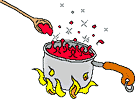 |
Sauces |  |
|
Prevent lumps in cornstarch or flour thickened sauces by stirring constantly. If lumps do form, beat the sauce briskly with a wire whisk or rotary beater. If necessary, press through a strainer to remove lumps. If you are making gravies or sauces in large quantities, it will take much longer to get rid of the raw flour taste after the liquid has been added to the roux. When making a flour-based sauce the roux must be cooked to rid it of the flour flavor and must always be hot when added to cold liquids and cold when added to hot for it to work correctly. Save the liquids from canned fruits and thicken them with cornstarch; heat and serve as a sauce over cake or pudding. Loosen the browned bits in the bottom a skillet or roasting pan by adding liquid while stirring and heating; the resulting glaze is a flavor base for sauces and gravies. Intensify a flavor. "Cooking down" a food so that the water evaporates intensifies flavor. Reduce a cup of aged balsamic vinegar or orange juice to a syrup and drizzle it over grilled meat. Add a tablespoon of sugar to either reduction to make a savory topping for ice cream and fruit. As when using cornstarch or other thickeners, mix arrowroot with cold water until completely dissolved. Add the mixture to the sauce or liquid to be thickened, stirring constantly with a wire whisk or a wooden spoon until it reaches the desired consistency. If gravy is too salty add several pinches of brown sugar. To adjust a salty sauce try adding a diced potato, allow to cook for ten minutes and remove. To use arrowroot, mix it with cold water until completely dissolved then add the mixture to your sauce or liquid to be thickened, stirring constantly with a wire whisk until it reaches desired consistency. Immediately remove from heat to keep from over thickening. Use arrowroot only when the dish is to be served within 10 minutes of preparation. It will not hold heat, nor will it reheat. Pour pan drippings into a tall jar. The grease will rise to the top in minutes and can be removed for grease free gravy. Placing flour in a custard cup in the oven next to a roast will assure nice brown flour for gravy when the meat is done. When making spaghetti sauce, rub cold butter or oil all around the inside of the pot, from the top right down to the sauce. Do this and you will never have sauce splatter on your stove. It will simmer just to the butter line and no further. Don't overcook foods thickened with cornstarch because the cornstarch may break down and thin the food. Mix equal parts flour and cornstarch and store in a jar with a tight lid. Place 3-4 T. of this mixture in another jar and add some water. Put the lid on, shake the jar, and in a few minutes, you will have a smooth paste to add to pan drippings for a great gravy. For instant white sauce, blend a cup each of softened butter and flour and spread it evenly in an ice cube tray. Freeze, then cut into 16 cubes and store in a plastic bag until you want to make a sauce. Then heat 1 cup milk and 1 cube, stirring until the cube is melted and the liquid is warm. Stir in a tsp of peanut butter to burned gravy to hide the taste.
|
! Disclaimer !
Return to Cooking Hints Index Page